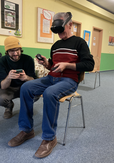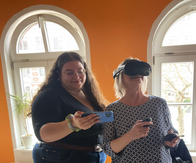Previously on GROOVE... – A short recap of what's happened so far
As part of the annual BMFTR meeting of all »Nähe über Distanz« (»Proximity over distance«) projects, we presented a short recap video showcasing our work and how friends and family living at a distance can benefit from it. (Video in German)

GROOVE - Experienced synchronization for remote intimacy in social VR
von HCI-Lab-Weimar
Klicken Sie auf den Play-Button, um externe Inhalte von Vimeo.com zu laden und anzuzeigen.
Externe Inhalte von Vimeo.com zukünftig automatisch laden und anzeigen (Sie können diese Einstellung jederzeit über unsere »Datenschutzerklärung« ändern.)
Conference presentation on Measuring Entrainment Experiences
The Ilmenau team presented their work on developing a new questionnaire focused on entrainment experience:
Stelzmann, D., Yin, Y., & Döring, N. (2025, September 10-12). Measuring Entrainment Experiences: A New Scale for Real-World and Virtual Reality Environments. Presentation at the Conference of the German Society of Psychology Media-Psychology division (DGPs-Fachgruppe Medienpsychologie) in Duisburg, Germany.
CHI'25 paper accepted & presented
Our submission investigating latency effects, studying the influence of frequency and Stimulus Onset Asynchrony (SOA) on synchrony perception during rhythmic audiovisual experiences was accepted for ACM CHI 2025 and presented by Lina in Japan. Congratulations to Lina + Jan (our eye-tracking experts)
Lina Klass, Anton Benjamin Lammert, Laura Simon, Bernd Fröhlich, Eva Hornecker, Jan Ehlers: "Perceived Asynchrony of Rhythmic Stimuli Affects Pupil Diameter and Smooth Pursuit Eye Movements"
In networked applications, latency can disrupt the sense of synchrony by causing offsets e.g. between local speech and remote visual response. We investigate the influence of frequency and Stimulus Onset Asynchrony (SOA) on synchrony perception during rhythmic audiovisual experiences. Our results show that the Point of Subjective Synchrony (PSS) is influenced by frequency, whereas the Window of Subjective Synchrony (WSS) is not. Variations in SOA induce adaptive gaze behavior in response to audiovisual latencies, while pupil diameter increases with increasing SOA, suggesting a higher cognitive load for successive unisensory rather than integrated events. This has practical implications for the design of computer-mediated applications that promote a sense of community through rhythmic interaction. Eye tracking data may indicate perceived (a)synchrony in audiovisual integration. In addition, the choice of frequencies may help to mask latencies, enhance the experience of synchrony and thus support feelings of closeness and intimacy in virtual interaction.

CHI '25: Perceived Asynchrony of Rhythmic Stimuli Affects Pupil Diameter and Smooth Pursuit Eye Movements
Klicken Sie auf den Play-Button, um externe Inhalte von Vimeo.com zu laden und anzuzeigen.
Externe Inhalte von Vimeo.com zukünftig automatisch laden und anzeigen (Sie können diese Einstellung jederzeit über unsere »Datenschutzerklärung« ändern.)
Klass, L., Lammert, A., Simon, L., Hornecker, E., Froehlich, B., Ehlers, J. (2025). Perceived Asynchrony of Rhythmic Stimuli Affects Pupil Diameter and Smooth Pursuit Eye Movements. In 2025 ACM CHI Conference on Human Factors in Computing Systems, Yokohama, Japan. https://dl.acm.org/doi/10.1145/3706598.3713152
Paper published at SUI'24
Laura attended SUI (ACM Conference on Spatial User Interfaces) in Trier to present findings from our first project phase, where we took effort to investigate older and young adults desires for social VR activities. The needs and desires of older adults for VR, especially social VR, are still under-researched and we had some interesting observations which will be useful for our goal to create appealing and engaging intergenerational activities within social VR. SUI provided a good opportunity to discuss issues around VR and entrainment with experts in the field.
Laura Simon, Lina Klass, Anton Benjamin Lammert, Bernd Froehlich, Jan Ehlers, Eva Hornecker. Social VR Activities Should Support Ongoing Conversation - Comparing Older and Young Adults Desires and Requirements. Proc. of ACM Symposium on Spatial User Interaction (SUI '24). ACM, Article 19, 1–13. doi.org/10.1145/3677386.3682089
Demo Video CommonGround Synchronisation
Consensive has been working on the CommonGround Networking system, which reduces latencies. This is their first demo video (link).
Workshop-Paper presented at MUM'23 in Vienna
We contributed a short paper to the workshop "Making A Real Connection: Pro-Social Collaborative Play in Extended Realities – Trends, Challenges and Potentials” at the Mobile and Ubiquitous Computing (MUC) Conference in December 2023 in Vienna. Laura, Lina and Eva reported on initial findings from interviews with potential future users: "Staying in Touch with Friends, Family and Partners at a Distance through Social Activities in VR – but which Activities are Desired?".
Laura presented the paper at the Workshop, which also was a nice chance to meet colleagues from the same BMBF program, and to discuss best practices and design principles for collaborative play in XR.
Requirements analysis for VR applications with senior users
In order to find out what requirements, wishes or concerns older users have for VR applications, we conducted interviews with groups of senior citizens. In order to get an impression of what is possible during VR interactions, they were invited to test some existing applications during the interviews.
After initial reservations, almost everyone was enthusiastic about this new technology once they had tried it out and reported that they could imagine using it to keep in touch with grandchildren living far away from them. In this context, especially cultural activities like visiting a musem seem to be favored.


